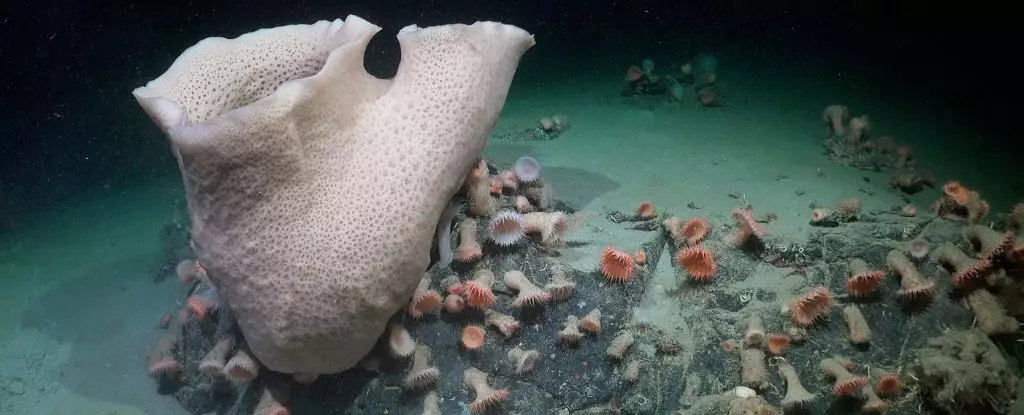In early 2025, the world witnessed a transformative event when a colossal iceberg, reminiscent of Chicago’s vast cityscape, separated from the George VI Ice Shelf in Antarctica. This unanticipated occurrence was not just an environmental spectacle but a revelation—an unveiling of ecosystems that had been cloistered from human sight for potentially centuries. As soon as researchers set sail to explore the newly freed seafloor, equipped with the advanced remotely operated vehicle, SuBastian, they stumbled into a vibrant marine haven flourishing amidst the darkness of perpetual ice cover. They discovered a thriving community of sponges, anemones, hydroids, and corals that brought forth an awe-inspiring image of resilience beneath Antarctic ice.
The vastness of the depths remains a mystery; what’s staggering is the realization that these ecosystems may have survived in complete isolation, relying solely on ocean currents to nourish them. The absence of sunlight and limited nutrient input from the surface raises queries regarding the tenacity of life in one of Earth’s harshest climates. Leading the expedition, Patricia Esquete of the Centre for Environmental and Marine Studies at the University of Aveiro epitomized that sense of wonder when she remarked, “We didn’t expect to find such a beautiful, thriving ecosystem.” Indeed, this assertion reflects an unsettling truth that many societies fail to grasp—nature continues to astound and teach us even when all seems bleak.
Rethinking Our Understanding of Ecosystems
Exciting, yet daunting, is the prospect that the scientists may not even scratch the surface of what these newfound ecosystems entail. Sorting through potential new species and understanding how life thrives in such an obscure and isolated environment could take decades. The sheer size of organisms spotted—some sponges potentially hundreds of years old—calls into question the endurance and adaptability of life. It begs the larger question: How resilient is the natural world, and what can it teach us about survival, adaptation, and balance?
This expedition to the Antarctic underbelly is a crucial reminder that areas previously thought to be inhospitable can harbor life worthy of our attention. Scientific explorations like these venture beyond mere data gathering; they represent a philosophical awakening about the interconnectedness of marine ecosystems and human impact on the environment. Despite climate change, these hidden communities persist, revealing that survival often lies merely beneath the ice.
The Serendipity of Discovery
Perhaps the most captivating aspect of this incident lies in the serendipity that cleaves through the dense strata of human endeavor. The timing of the iceberg’s breaking, coinciding with the researchers’ presence, illustrates a rare chance encounter with nature’s latent treasures—an accident that was nothing short of serendipitous. The expedition, originally intended for other marine investigations, transformed instantaneously into an unprecedented opportunity to study a newly revealed habitat. This juxtaposition of human scientists and unfathomable ecosystems speaks to the unique dynamics that often govern our exploration of the natural world.
Researchers, including co-leader Aleksandr Montelli from University College London, recognized the unprecedented significance of this occurrence in the scientific community. The intricate methods employed to navigate the ROVs under the immense ice thickness highlight not only ingenuity but also the delicate balance between exploration and preservation. With the absence of GPS systems in such remote conditions, scientists employed acoustic methods for navigation—a testament to human adaptability mirrored in the underwater life they observed.
Life Following Change: A New World
Further evidence of life’s resilience was found just a stone’s throw away from the calved iceberg, where previous ice shelves had long vanished. The research team observed corals congregating, alongside icefish and giant sea spiders, all eager to flourish in the newly vacated seabed. It raises an essential discourse surrounding ecological succession and the ability of nature to reclaim territory—an inspiring narrative amidst otherwise grim reflections on climate change.
Such findings ought to spur greater awareness of how vulnerable and, paradoxically, resilient ecosystems function. The intersection of human-induced climate events and biological renewal offers a much-needed narrative of hope and strength. In pursuing such studies, we not only amplify the voices of the natural world but engage in much-needed introspection as stewards of the environment. The unfolding saga beneath the Antarctic ice becomes paramount, pushing us to consider what responsibilities we hold as observers and participants within this remarkable planet.


Leave a Reply